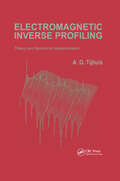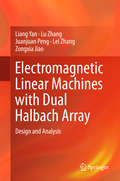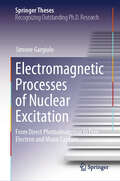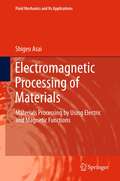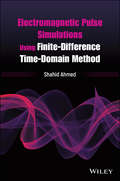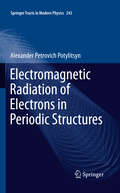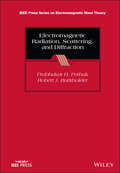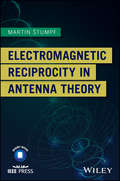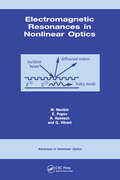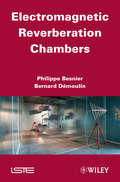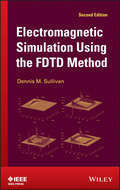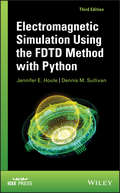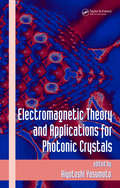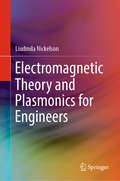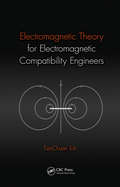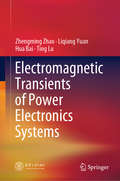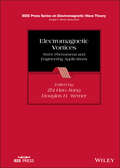- Table View
- List View
Electromagnetic Inverse Profiling: Theory and Numerical Implementation
by Antonius Gregorius TijhuisThis monograph is concerned with the direct-scattering of electromagnetic waves by one- and two-dimensional objects, and the use of this technique in one-dimensional inverse profiling. It discusses results of research into the method of this technique and its application to specific problems.Several techniques are presented for solving transient electromagnetic direct-scattering problems. These problems are solved indirectly, via a Fourier or Laplace transformation to the real- or complex-frequency domain, as well as directly in the time domain.For the one-dimensional case it is described how the special features of the respective techniques are also exploited to tackle the inverse problem of determining obstacle properties from the scattered field excited by a known incident field. The problems of both identification and of inverse profiling are addressed.For a range of specific problems representative numerical results are presented and discussed. Particular attention is devoted to the numerical implementation and to the physical interpretation of the theoretical numerical results obtained. With respect to inverse-scattering the emphasis is on the band-limiting effects that may arise due to approximation errors in the various inversion schemes employed.
Electromagnetic Linear Machines with Dual Halbach Array
by Lei Zhang Lu Zhang Liang Yan Juanjuan Peng Zongxia JiaoThis book extends the conventional two-dimensional (2D) magnet arrangement into 3D pattern for permanent magnet linear machines for the first time, and proposes a novel dual Halbach array. It can not only effectively increase the radial component of magnetic flux density and output force of tubular linear machines, but also significantly reduce the axial flux density, radial force and thus system vibrations and noises. The book is also the first to address the fundamentals and provide a summary of conventional arrays, as well as novel concepts for PM pole design in electric linear machines. It covers theoretical study, numerical simulation, design optimization and experimental works systematically. The design concept and analytical approaches can be implemented to other linear and rotary machines with similar structures. The book will be of interest to academics, researchers, R&D engineers and graduate students in electronic engineering and mechanical engineering who wish to learn the core principles, methods, and applications of linear and rotary machines.
Electromagnetic Metasurfaces: Theory and Applications (Wiley - IEEE)
by Christophe Caloz Karim AchouriDiscover a comprehensive exploration of recent developments and fundamental concepts in the applications of metasurfaces. In Electromagnetic Metasurfaces: Theory and Applications, distinguished researchers and authors Karim Achouri and Christophe Caloz deliver an introduction to the fundamentals and applications of metasurfaces and an insightful analysis of recent and future developments in the field. The book describes the precursors and history of metasurfaces before continuing on to an exploration of the physical insights that can be gleaned from the material parameters of the metasurface. You’ll learn how to compute the fields scattered by a metasurface with known material parameters being illuminated by an arbitrary incident field, as well as how to realize a practical metasurface and relate its material parameters to its physical structures. The authors provide examples to illustrate all the concepts discussed in the book to improve and simplify reader understanding. Electromagnetic Metasurfaces concludes with an incisive discussion of the likely future directions and research opportunities in the field. Readers will also benefit from the inclusion of: A thorough introduction to metamaterials, the concept of metasurfaces, and metasurface precursors An exploration of electromagnetic modeling and theory, including metasurfaces as zero-thickness sheets and bianisotropic susceptibility tensors A practical discussion of susceptibility synthesis, including four-parameters synthesis, more than four-parameters synthesis, and the addition of susceptibility components A concise treatment of scattered-field analysis, including approximate analytical methods, and finite-difference frequency-domain techniques Perfect for researchers in metamaterial sciences and engineers working with microwave, THz, and optical technologies, Electromagnetic Metasurfaces: Theory and Applications will also earn a place in the libraries of graduate and undergraduate students in physics and electrical engineering.
Electromagnetic Methods in Geophysics: Applications in GeoRadar, FDEM, TDEM, and AEM
by Giovanni Leucci Fabio GianninoDiscover the utility of four popular electromagnetic geophysical techniques In GeoRadar, FDEM, TDEM, and AEM Methods, accomplished researchers Fabio Giannino and Giovanni Leucci deliver an in-depth exploration of the theory and application of four different electromagnetic geophysical techniques: ground penetrating radar, the frequency domain electromagnetic method, the time domain electromagnetic method, and the airborne electromagnetic method. The authors offer a full description of each technique as they relate to the economics, planning, and logistics of deploying each of them on-site. The book also discusses the potential output of each method and how it can be combined with other sources of below- and above-ground information to create a digitized common point cloud containing a wide variety of data. Giannino and Leucci rely on 25 years of professional experience in over 40 countries around the world to provide readers with a fulsome description of the optimal use of GPR, FDEM, TDEM, and AEM, demonstrating their flexibility and applicability to a wide variety of use cases. Readers will also benefit from the inclusion of: A thorough introduction to electromagnetic theory, including the operative principles and theory of ground penetrating radar (GPR) and the frequency domain electromagnetic method (FDEM) An exploration of hardware architecture and surveying, including GPR, FDEM, time domain electromagnetic method (TDEM), and airborne electromagnetic (AEM) surveying A collection of case studies, including a multiple-geophysical archaeological GPR survey in Turkey and a UXO search in a building area in Italy using FDEM /li> Discussions of planning and mobilizing a campaign, the shipment and clearance of survey equipment, and managing the operative aspects of field activity Perfect for forensic and archaeological geophysicists, GeoRadar, FDEM, TDEM, and AEM Methods will also earn a place in the libraries of anyone seeking a one-stop reference for the planning and deployment of GDR, FDEM, TDEM, and AEM surveying techniques.
Electromagnetic Modeling and Simulation (IEEE Press Series on Electromagnetic Wave Theory)
by Levent SevgiThis unique book presents simple, easy-to-use, but effective short codes as well as virtual tools that can be used by electrical, electronic, communication, and computer engineers in a broad range of electrical engineering problems Electromagnetic modeling is essential to the design and modeling of antenna, radar, satellite, medical imaging, and other applications. In this book, author Levent Sevgi explains techniques for solving real-time complex physical problems using MATLAB-based short scripts and comprehensive virtual tools. Unique in coverage and tutorial approach, Electromagnetic Modeling and Simulation covers fundamental analytical and numerical models that are widely used in teaching, research, and engineering designs—including mode and ray summation approaches with the canonical 2D nonpenetrable parallel plate waveguide as well as FDTD, MoM, and SSPE scripts. The book also establishes an intelligent balance among the essentials of EM MODSIM: The Problem (the physics), The Theory and Models (mathematical background and analytical solutions), and The Simulations (code developing plus validation, verification, and calibration). Classroom tested in graduate-level and short courses, Electromagnetic Modeling and Simulation: Clarifies concepts through numerous worked problems and quizzes provided throughout the book Features valuable MATLAB-based, user-friendly, effective engineering and research virtual design tools Includes sample scenarios and video clips recorded during characteristic simulations that visually impact learning—available on wiley.com Provides readers with their first steps in EM MODSIM as well as tools for medium and high-level code developers and users Electromagnetic Modeling and Simulation thoroughly covers the physics, mathematical background, analytical solutions, and code development of electromagnetic modeling, making it an ideal resource for electrical engineers and researchers.
Electromagnetic Phenomena in Matter
by Igor N. ToptyginModern electrodynamics in different media is a wide branch of electrodynamics which combines the exact theory of electromagnetic fields in the presence of electric charges and currents with statistical description of these fields in gases, plasmas, liquids and solids; dielectrics, conductors and superconductors. It is widely used in physics and in other natural sciences (such as astrophysics and geophysics, biophysics, ecology and evolution of terrestrial climate), and in various technological applications (radio electronics, technology of artificial materials, laser-based technological processes, propagation of bunches of charges particles, linear and nonlinear electromagnetic waves, etc.). Electrodynamics of matter is based on the exact fundamental (microscopic) electrodynamics but is supplemented with specific descriptions of electromagnetic fields in various media using the methods of statistical physics, quantum mechanics, physics of condensed matter (including theory of superconductivity), physical kinetics and plasma physics. This book presents in one unique volume a systematic description of the main electrodynamic phenomena in matter: - A large variety of theoretical approaches used in describing various media - Numerous important manifestations of electrodynamics in matter (magnetic materials, superconductivity, magnetic hydrodynamics, holography, radiation in crystals, solitons, etc.) - A description of the applications used in different branches of physics and many other fields of natural sciences - Describes the whole complexity of electrodynamics in matter including material at different levels. - Oriented towards 3-4 year bachelors, masters, and PhD students, as well as lectures, and engineers and scientists working in the field. - The reader will need a basic knowledge of general physics, higher mathematics, classical mechanics and microscopic (fundamental) electrodynamics at the standard university level - All examples and problems are described in detail in the text to help the reader learn how to solve problems - Advanced problems are marked with one asterisk, and the most advanced ones with two asterisks. Some problems are recommended to be solved first, and are are marked by filled dots; they are more general and important or contain results used in other problems.
Electromagnetic Processes of Nuclear Excitation: From Direct Photoabsorption to Free Electron and Muon Capture (Springer Theses)
by Simone GargiuloFor decades, scientists have envisioned the possibility of storing energy in the form of nuclear excitations, resulting in specific nuclear configurations known as isomers. These unique metastable states have the ability to maintain their excited state for periods that range from several years to time spans exceeding the age of the Universe. However, despite numerous research efforts, achieving effective and practical control over isomer activation or depletion continues to be an unresolved challenge. This book delves into the world of isomers, beginning with an accessible overview of their essential properties and significance as long-duration energy storage solutions. Across the chapters, the book delves into diverse electromagnetic mechanisms responsible for nuclear excitation. It presents the ongoing debate surrounding the Nuclear Excitation by Electron Capture (NEEC) process, offering a comprehensivehistorical background that ranges from its early proposal to the latest tools employed for its investigation. The subsequent chapter explores the possibilities of using muons, introducing a novel process called Nuclear Excitation by Free Muon Capture (NEμC). The primary aim of these sections is to identify methods that could either increase the likelihood of these nuclear processes or provide real-time external manipulation over them. In the last chapter, the book revisits the process of nuclear photoabsorption in optical laser-generated plasma through experimental efforts, offering a fresh interpretation of existing literature results. Overall, the book delivers a clear and comprehensive overview, aiming to assist newcomers and established scientists in quickly grasping the core aspects of the subjects, possibly guiding their research endeavors. Hopefully, this resource will act as a catalyst for sparking new ideas while providing insights into the intricacies and opportunitiespresented by nuclear excitations within the realm of nuclear physics.
Electromagnetic Processing of Materials
by Shigeo AsaiThis book is both a course book and a monograph. In fact, it has developed from notes given to graduate course students on materials processing in the years 1989 to 2006. Electromagnetic Processing of Materials (EPM), originates from a branch of materials science and engineering developed in the 1980s as a field aiming to create new materials and/or design processes by making use of various functions which appear when applying the electric and magnetic fields to materials. It is based on transport phenomena, materials processing and magnetohydrodynamics. The first chapter briefly introduces the history, background and technology of EPM. In the second chapter, the concept of transport phenomena is concisely introduced and in the third chapter the essential part of magnetohydrodynamics is transcribed and readers are shown that the concept of transport phenomena does not only apply to heat, mass and momentum, but also magnetic field. The fourth chapter describes electromagnetic processing of electrically conductive materials such as electromagnetic levitation, mixing, brake, and etc., which are caused by the Lorentz force. The fifth chapter treats magnetic processing of organic and non-organic materials such as magnetic levitation, crystal orientation, structural alignment and etc., which are induced by the magnetization force. This part is a new academic field named Magneto-Science, which focuses on the development of super-conducting magnets. This book is written so as to be understood by any graduate student in engineering courses but also to be of interest to engineers and researchers in industries.
Electromagnetic Pulse Simulations Using Finite-Difference Time-Domain Method
by Shahid AhmedDiscover the utility of the FDTD approach to solving electromagnetic problems with this powerful new resource Electromagnetic Pulse Simulations Using Finite-Difference Time-Domain Method delivers a comprehensive overview of the generation and propagation of ultra-wideband electromagnetic pulses. The book provides a broad cross-section of studies of electromagnetic waves and their propagation in free space, dielectric media, complex media, and within guiding structures, like waveguide lines, transmission lines, and antennae. The distinguished author offers readers a fresh new approach for analyzing electromagnetic modes for pulsed electromagnetic systems designed to improve the reader’s understanding of the electromagnetic modes responsible for radiating far-fields. The book also provides a wide variety of computer programs, data analysis techniques, and visualization tools with state-of-the-art packages in MATLAB, OCTAVE, and SCILAB. Following an introduction and clarification of basic electromagnetics and the frequency and time domain approach, the book delivers explanations of different numerical methods frequently used in computational electromagnetics and the necessity for the time domain treatment. In addition to a discussion of the Finite-difference Time-domain (FDTD) approach, readers will also enjoy: A thorough introduction to electromagnetic pulses (EMPs) and basic electromagnetics, including common applications of electromagnetics and EMP coupling and its effects An exploration of time and frequency domain analysis in electromagnetics, including Maxwell's equations and their practical implications A discussion of electromagnetic waves and propagation, including waves in free space, dielectric mediums, complex mediums, and guiding structures A treatment of computational electromagnetics, including an explanation of why we need modeling and simulations Perfect for undergraduate and graduate students taking courses in physics and electrical and electronic engineering, Electromagnetic Pulse Simulations Using Finite-Difference Time-Domain Method will also earn a place in the libraries of scientists and engineers working in electromagnetic research, RF and microwave design, and electromagnetic interference.
Electromagnetic Radiation in Analysis and Design of Organic Materials: Electronic and Biotechnology Applications
by Andreea Irina Barzic Dana Ortansa Dorohoi Magdalena AfloriBridging condensed matter physics, photochemistry, photophysics, and materials science, Electromagnetic Radiation in Analysis and Design of Organic Materials: Electronic and Biotechnology Applications covers physical properties of materials in the presence of radiation from across the electromagnetic spectrum. It describes the optical, spectral, thermal, and morphological properties of a wide range of materials and their practical implications in electronic and biotechnologies. It discusses recent advances in the use of radiation in analysis of materials and design for advanced applications. The book contains experimental and theoretical issues that reflect the impact of radiation on materials characteristics highlighting their ease of analysis or adaptation for applications as optical filters, drug delivery systems, antimicrobial layers, amphetamine detectors, or liquid crystal displays.
Electromagnetic Radiation of Electrons in Periodic Structures
by Alexander PotylitsynPeriodic magnetic structures (undulators) are widely used in accelerators to generate monochromatic undulator radiation (UR) in the range from far infrared to the hard X-ray region. Another periodic crystalline structure is used to produce quasimonochromatic polarized photon beams via the coherent bremsstrahlung mechanism (CBS). Due to such characteristics as monochromaticity, polarization and adjustability, these types of radiation is of large interest for applied and basic research of accelerator-emitted radiation. The book provides a detailed overview of the fundamental principles behind electromagnetic radiation emitted from accelerated charged particles (e.g. UR, CBS, radiation of fast electrons in Laser flash fields) as well as a unified description of relatively new radiation mechanisms which attracted great interest in recent years. This are the so-called polarization radiation excited by the Coulomb field of incident particles in periodic structures, parametric X-rays, resonant transition radiation and the Smith-Purcell effect. Characteristics of such radiation sources and perspectives of their usage are discussed. The recent experimental results as well as their interpretation are presented.
Electromagnetic Radiation, Scattering, and Diffraction (IEEE Press Series on Electromagnetic Wave Theory)
by Prabhakar H. Pathak Robert J. BurkholderElectromagnetic Radiation, Scattering, and Diffraction Discover a graduate-level text for students specializing in electromagnetic wave radiation, scattering, and diffraction for engineering applications In Electromagnetic Radiation, Scattering and Diffraction, distinguished authors Drs. Prabhakar H. Pathak and Robert J. Burkholder deliver a thorough exploration of the behavior of electromagnetic fields in radiation, scattering, and guided wave environments. The book tackles its subject from first principles and includes coverage of low and high frequencies. It stresses physical interpretations of the electromagnetic wave phenomena along with their underlying mathematics. The authors emphasize fundamental principles and provide numerous examples to illustrate the concepts contained within. Students with a limited undergraduate electromagnetic background will rapidly and systematically advance their understanding of electromagnetic wave theory until they can complete useful and important graduate-level work on electromagnetic wave problems. Electromagnetic Radiation, Scattering and Diffraction also serves as a practical companion for students trying to simulate problems with commercial EM software and trying to better interpret their results. Readers will also benefit from the breadth and depth of topics, such as: Basic equations governing all electromagnetic (EM) phenomena at macroscopic scales are presented systematically. Stationary and relativistic moving boundary conditions are developed. Waves in planar multilayered isotropic and anisotropic media are analyzed. EM theorems are introduced and applied to a variety of useful antenna problems. Modal techniques are presented for analyzing guided wave and periodic structures. Potential theory and Green's function methods are developed to treat interior and exterior EM problems. Asymptotic High Frequency methods are developed for evaluating radiation Integrals to extract ray fields. Edge and surface diffracted ray fields, as well as surface, leaky and lateral wave fields are obtained. A collective ray analysis for finite conformal antenna phased arrays is developed. EM beams are introduced and provide useful basis functions. Integral equations and their numerical solutions via the method of moments are developed. The fast multipole method is presented. Low frequency breakdown is studied. Characteristic modes are discussed. Perfect for graduate students studying electromagnetic theory, Electromagnetic Radiation, Scattering, and Diffraction is an invaluable resource for professional electromagnetic engineers and researchers working in this area.
Electromagnetic Reciprocity in Antenna Theory
by Martin StumpfProvides a self-contained account on applications of electromagnetic reciprocity theorems to multiport antenna systems The reciprocity theorem is among the most intriguing concepts in wave field theory and has become an integral part of almost all standard textbooks on electromagnetic (EM) theory. This book makes use of the theorem to quantitatively describe EM interactions concerning general multiport antenna systems. It covers a general reciprocity-based description of antenna systems, their EM scattering properties, and further related aspects. Beginning with an introduction to the subject, Electromagnetic Reciprocity in Antenna Theory provides readers first with the basic prerequisites before offering coverage of the equivalent multiport circuit antenna representations, EM coupling between multiport antenna systems and their EM interactions with scatterers, accompanied with the corresponding EM compensation theorems. In addition, the text: Presents basic prerequisites including the definition of the notation, integral transformations, and EM reciprocity theorems in their general form Explores multiport antenna forward-scattering theorem, multiport antenna matching theorem and uniqueness theorem Supplements each chapter with a solved illustrative example Electromagnetic Reciprocity in Antenna Theory is an excellent text for EMC and antenna researchers and students of the subject as well.
Electromagnetic Resonances in Nonlinear Optics (Advances in Nonlinear Optics)
by Michel Neviere R. Reinisch E. Popov G. VitrantThis book is devoted to the numerous phenomena arising from the interplay between electromagnetic resonances and nonlinear optical interactions. These resonances are associated with surface plasmas or guided waves, excited in nonlinear optical resonators such as prisms or grating couplers. Topics include rigorous theories of diffraction by gratings
Electromagnetic Reverberation Chambers
by Philippe Besnier Bernard DémoulinDedicated to a complete presentation on all aspects of reverberation chambers, this book provides the physical principles behind these test systems in a very progressive manner. The detailed panorama of parameters governing the operation of electromagnetic reverberation chambers details various applications such as radiated immunity, emissivity, and shielding efficiency experiments. In addition, the reader is provided with the elements of electromagnetic theory and statistics required to take full advantage of the basic operational rules of reverberation chambers, including calibration procedures. Comparisons with other testing systems (TEM cells, anechoic chambers) are also discussed.
Electromagnetic Scattering by Particles and Particle Groups
by Michael I. MishchenkoThis self-contained and accessible book provides a thorough introduction to the basic physical and mathematical principles required in studying the scattering and absorption of light and other electromagnetic radiation by particles and particle groups. For the first time the theories of electromagnetic scattering, radiative transfer, and weak localization are combined into a unified, consistent branch of physical optics directly based on the Maxwell equations. A particular focus is given to key aspects such as time and ensemble averaging at different scales, ergodicity, and the physical nature of measurements afforded by actual photopolarimeters. Featuring over 120 end-of-chapter exercises, with hints and solutions provided, this clear, one-stop resource is ideal for self-study or classroom use, and will be invaluable to both graduate students and researchers in remote sensing, physical and biomedical optics, optical communications, optical particle characterization, atmospheric physics, and astrophysics.
Electromagnetic Simulation Using the FDTD Method (Ieee Press Series On Rf And Microwave Technology Ser. #5)
by Dennis M. SullivanA straightforward, easy-to-read introduction to the finite-difference time-domain (FDTD) method Finite-difference time-domain (FDTD) is one of the primary computational electrodynamics modeling techniques available. Since it is a time-domain method, FDTD solutions can cover a wide frequency range with a single simulation run and treat nonlinear material properties in a natural way. Written in a tutorial fashion, starting with the simplest programs and guiding the reader up from one-dimensional to the more complex, three-dimensional programs, this book provides a simple, yet comprehensive introduction to the most widely used method for electromagnetic simulation. This fully updated edition presents many new applications, including the FDTD method being used in the design and analysis of highly resonant radio frequency (RF) coils often used for MRI. Each chapter contains a concise explanation of an essential concept and instruction on its implementation into computer code. Projects that increase in complexity are included, ranging from simulations in free space to propagation in dispersive media. Additionally, the text offers downloadable MATLAB and C programming languages from the book support site (http://booksupport.wiley.com). Simple to read and classroom-tested, Electromagnetic Simulation Using the FDTD Method is a useful reference for practicing engineers as well as undergraduate and graduate engineering students.
Electromagnetic Simulation Using the FDTD Method with Python
by Dennis M. Sullivan Jennifer E. HouleProvides an introduction to the Finite Difference Time Domain method and shows how Python code can be used to implement various simulations This book allows engineering students and practicing engineers to learn the finite-difference time-domain (FDTD) method and properly apply it toward their electromagnetic simulation projects. Each chapter contains a concise explanation of an essential concept and instruction on its implementation into computer code. Included projects increase in complexity, ranging from simulations in free space to propagation in dispersive media. This third edition utilizes the Python programming language, which is becoming the preferred computer language for the engineering and scientific community. Electromagnetic Simulation Using the FDTD Method with Python, Third Edition is written with the goal of enabling readers to learn the FDTD method in a manageable amount of time. Some basic applications of signal processing theory are explained to enhance the effectiveness of FDTD simulation. Topics covered in include one-dimensional simulation with the FDTD method, two-dimensional simulation, and three-dimensional simulation. The book also covers advanced Python features and deep regional hyperthermia treatment planning. Electromagnetic Simulation Using the FDTD Method with Python: Guides the reader from basic programs to complex, three-dimensional programs in a tutorial fashion Includes a rewritten fifth chapter that illustrates the most interesting applications in FDTD and the advanced graphics techniques of Python Covers peripheral topics pertinent to time-domain simulation, such as Z-transforms and the discrete Fourier transform Provides Python simulation programs on an accompanying website An ideal book for senior undergraduate engineering students studying FDTD, Electromagnetic Simulation Using the FDTD Method with Python will also benefit scientists and engineers interested in the subject.
Electromagnetic Theory and Applications for Photonic Crystals (Optical Science and Engineering)
by Kiyotoshi YasumotoPhotonic technology promises much faster computing, massive parallel processing, and an evolutionary step in the digital age. The search continues for devices that will enable this paradigm, and these devices will be based on photonic crystals. Modeling is a key process in developing crystals with the desired characteristics and performance, and Electromagnetic Theory and Applications for Photonic Crystals provides the electromagnetic-theoretical models that can be effectively applied to modeling photonic crystals and related optical devices.The book supplies eight self-contained chapters that detail various analytical, numerical, and computational approaches to the modeling of scattering and guiding problems. For each model, the chapter begins with a brief introduction, detailed formulations of periodic structures and photonic crystals, and practical applications to photonic crystal devices. Expert contributors discuss the scattering matrix method, multipole theory of scattering and propagation, model of layered periodic arrays for photonic crystals, the multiple multipole program, the mode-matching method for periodic metallic structures, the method of lines, the finite-difference frequency-domain technique, and the finite-difference time-domain technique.Based on original research and application efforts, Electromagnetic Theory and Applications for Photonic Crystals supplies a broad array of practical tools for analyzing and designing devices that will form the basis for a new age in computing.
Electromagnetic Theory and Plasmonics for Engineers
by Liudmila NickelsonThis book presents the theory of electromagnetic (EM) waves for upper undergraduate, graduate and PhD-level students in engineering. It focuses on physics and microwave theory based on Maxwell’s equations and the boundary conditions important for studying the operation of waveguides and resonators in a wide frequency range, namely, from approx. 10**9 to 10**16 hertz. The author also highlights various current topics in EM field theory, such as plasmonic (comprising a noble metal) waveguides and analyses of attenuations by filled waveguide dielectrics or semiconductors and also by conducting waveguide walls. Featuring a wide variety of illustrations, the book presents the calculated and schematic distributions of EM fields and currents in waveguides and resonators. Further, test questions are presented at the end of each chapter.
Electromagnetic Theory for Electromagnetic Compatibility Engineers
by Tze-Chuen TohEngineers and scientists who develop and install electronic devices and circuits need to have a solid understanding of electromagnetic theory and the electromagnetic behavior of devices and circuits. In particular, they must be well-versed in electromagnetic compatibility, which minimizes and controls the side effects of interconnected electric dev
Electromagnetic Time Reversal: Application to EMC and Power Systems
by Farhad Rachidi Marcos Rubinstein Mario PaoloneThe aim of this book is to familiarize the reader with the concept of electromagnetic time reversal, and introduce up-to-date applications of the concept found in the areas of electromagnetic compatibility and power systems. It is original in its approach to describing propagation and transient issues in power networks and power line communication, and is the result of the three main editors’ pioneering research in the area.
Electromagnetic Transients of Power Electronics Systems
by Hua Bai Zhengming Zhao Liqiang Yuan Ting LuThis book discusses topics related to power electronics, especially electromagnetic transient analysis and control of high-power electronics conversion. It focuses on the re-evaluation of power electronics, transient analysis and modeling, device-based system-safe operating area, and energy balance-based control methods, and presenting, for the first time, numerous experimental results for the transient process of various real-world converters.The book systematically presents both theoretical analysis and practical applications. The first chapter discusses the structure and attributes of power electronics systems, highlighting the analysis and synthesis, while the second chapter explores the transient process and modeling for power electronics systems. The transient features of power devices at switching-on/off, transient conversion circuit with stray parameters and device-based system-safe operating area are described in the subsequent three chapters. The book also examines the measurement of transient processes, electromagnetic pulses and their series, as well as high-performance, closed-loop control, and expounds the basic principles and method of the energy-balanced control strategy. Lastly, it introduces the applications of transient analysis of typical power electronics systems.The book is valuable as a textbook for college students, and as a reference resource for electrical engineers as well as anyone working in the field of high-power electronics system.
Electromagnetic Vibration Energy Harvesting Devices
by Dirk Spreemann Yiannos ManoliElectromagnetic vibration transducers are seen as an effective way of harvesting ambient energy for the supply of sensor monitoring systems. Different electromagnetic coupling architectures have been employed but no comprehensive comparison with respect to their output performance has been carried out up to now. Electromagnetic Vibration Energy Harvesting Devices introduces an optimization approach which is applied to determine optimal dimensions of the components (magnet, coil and back iron). Eight different commonly applied coupling architectures are investigated. The results show that correct dimensions are of great significance for maximizing the efficiency of the energy conversion. A comparison yields the architectures with the best output performance capability which should be preferably employed in applications. A prototype development is used to demonstrate how the optimization calculations can be integrated into the design-flow. Electromagnetic Vibration Energy Harvesting Devices targets the designer of electromagnetic vibration transducers who wishes to have a greater in-depth understanding for maximizing the output performance.
Electromagnetic Vortices: Wave Phenomena and Engineering Applications (IEEE Press Series on Electromagnetic Wave Theory)
by Zhi Hao Jiang Douglas H. WernerDiscover the most recent advances in electromagnetic vortices In Electromagnetic Vortices: Wave Phenomena and Engineering Applications, a team of distinguished researchers delivers a cutting-edge treatment of the research and development of electromagnetic vortex waves, including their related wave properties and several potentially transformative applications. The book is divided into three parts. The editors first include resources that describe the generation, sorting, and manipulation of vortex waves, as well as descriptions of interesting wave behavior in the infrared and optical regimes with custom-designed nanostructures. They then discuss the generation, multiplexing, and propagation of vortex waves at the microwave and millimeter-wave frequencies. Finally, the selected contributions discuss several representative practical applications of vortex waves from a system perspective. With coverage that incorporates demonstration examples from a wide range of related sub-areas, this essential edited volume also offers: Thorough introductions to the generation of optical vortex beams and transformation optical vortex wave synthesizers Comprehensive explorations of millimeter-wave metasurfaces for high-capacity and broadband generation of vector vortex beams, as well as OAM detection and its observation in second harmonic generations Practical discussions of microwave SPP circuits and coding metasurfaces for vortex beam generation and orbital angular momentum-based structured radio beams and their applications In-depth examinations of OAM multiplexing using microwave circuits for near-field communications and wireless power transmission Perfect for students of wireless communications, antenna/RF design, optical communications, and nanophotonics, Electromagnetic Vortices: Wave Phenomena and Engineering Applications is also an indispensable resource for researchers at large defense contractors and government labs.
